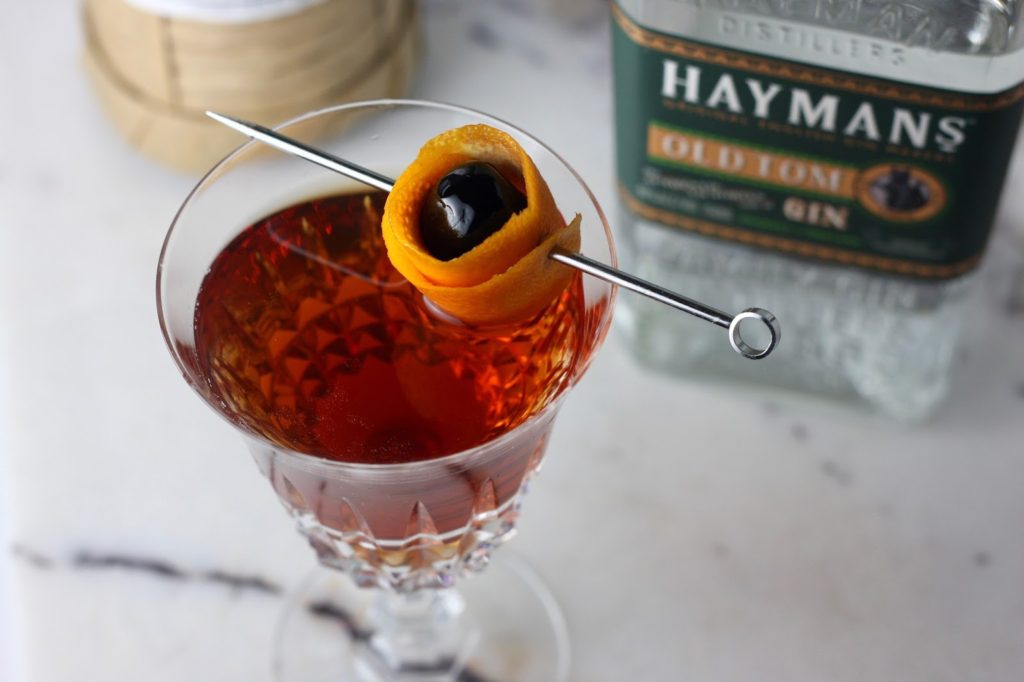I’ve covered a lot of the really classic cocktails on here, but the Martinez has been a glaring omission. It admittedly hasn’t maintained the popularity of some other recipes from the same era – and I’ll talk about why that might be – but as the likely ancestor of the modern Martini, it remains an essential drink to know. And it’s pretty tasty in its own right.
The reason I haven’t made a Martinez until now was because I wanted to make it properly, or at least as close to that as I could come. And that meant I needed a bottle of Old Tom gin. Here’s a quick refresher of your gin history: the ancestor of modern-day gin is genever, which originated in Holland. This method of making grain alcohol and flavoring it with herbs like juniper became wildly popular in England during the early 18th century, when there was a heavy tax on alcohol imports and people had to make their own spirits, usually from sub-par grains that weren’t good enough for making beer. Flavoring the resulting liquor helped mask this. Hanging a sign with a black cat outside of a drinking establishment was a signal that gin was served there, and so it became known as Old Tom. While less sweet and bready than genever, Old Tom is sweeter and maltier than modern dry gins.
Old Tom made its way to the states and was the gin used in the Tom Collins and other early gin drinks. However, a preference for drier cocktails developed and distilling methods improved, paving the way for classic London Dry gin and causing Old Tom to fall out of favor. But in our modern cocktail renaissance, of course there are distillers producing this classic gin once again. The easiest to find is Hayman’s. It’s also very affordable – I got my bottle for only $20.
The Martinez is in the same family as a Manhattan or Negroni in taste, but it has a distinct flavor and sweetness provided by the Old Tom and the maraschino liqueur. You certainly could make one with a drier gin, but the inclusion of Old Tom definitely affects the flavor and makes it an exciting link to a past era.
History: As I mentioned in my post on the Martini, the history of the Martinez is quite murky. It is often attributed to Jerry Thomas, the “father of American mixology.” He worked at the Occidental Hotel in San Francisco, and the story goes that he would mix this cocktail up for commuters catching the ferry to Martinez. But it was not included in the first edition of his Bartender’s Guide, and there is no definitive proof that he created the recipe. The first mention of it in print is in O. H. Byron’s 1884 Modern Bartender’s Guide, three years before the recipe was published in the 1887 edition of Thomas’ book. Byron’s version is clearly a variation of the Manhattan, which gives us a pretty clear cocktail genealogy of Manhattan > Martinez > Martini.
I should note that there are a half-dozen other versions of the Martinez’s origin, from a bartender in the town of Martinez whipping it up to it being a celebratory cocktail for a gold miner who struck it rich. But however the drink came about, it was soon quite popular.
So why didn’t this popularity persist? One factor was certainly the decline of Old Tom gin and the preference for drier cocktails, as I mentioned above. It’s thought that this turned the Martinez into the Martini. Additionally, a Martinez recipe usually calls for Boker’s Bitters, which went out of production in 1906. The recipe was lost for over a century, until a man showed up at the London Bar Show with a small bottle. Dr. Adam Elmegirab studied the tiny sample for 18 months in order to replicate the original recipe. He began selling Boker’s Bitters once again in 2009. If you don’t have a bottle (like me), a combination of Angostura and orange bitters is a decent substitute.
And finally, there isn’t really one definitive recipe for the Martinez. Even Byron’s book wasn’t clear on exactly how to make one. Byron provides two different recipes for the Manhattan – one with dry vermouth and one with sweet – and then instructs to swap the rye for Old Tom gin to make a Martinez. Both versions persisted, with the drier one experiencing more popularity for a time, but ultimately sweet vermouth won out, perhaps because it was what Jerry Thomas used. Even now, bartenders seem to consider the Martinez a drink that’s open to interpretation, with different ratios of gin to vermouth and even additions such as curaçao or absinthe. I found multiple versions of the recipe and tried several to determine what I liked best. The winner is below.
Martinez
2 oz Old Tom gin
1 oz sweet vermouth
1/4 oz maraschino liqueur
2 dashes Boker’s bitters
or
2 dashes Angostura bitters
2 dashes orange bitters
Combine all ingredients in a mixing glass with ice and stir until chilled. Strain into a cocktail or coupe glass and garnish with an orange twist and/or a brandied cherry.
Recipe adapted from The Kitchn.
Historical information mostly from Imbibe and Gin Foundry.







